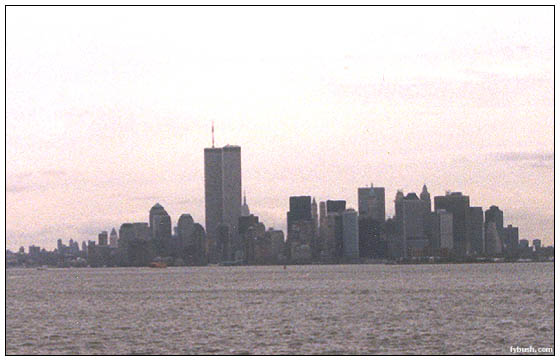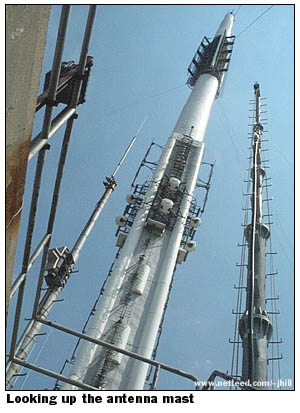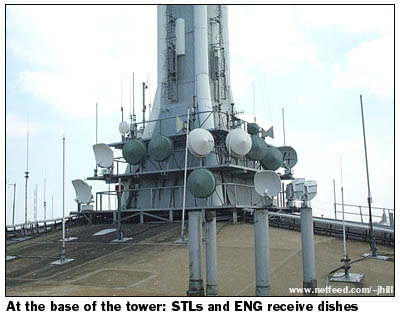September 11, 2002
One World Trade Center: A Look Back
(In memory of the first
anniversary of the destruction of the World Trade Center, we
reprise the Tower Site of the Week installment that first ran
here on September 12, 2001. Click
here for the NorthEast Radio Watch
special report on the recovery of TV and FM transmission after
the transmitter facilities on the World Trade Center were lost.)

It's still jarring, a few days after the attacks, to realize
that the skyline you see above no longer exists. This was the
view from the Staten Island Ferry back in February, on the way
to Manhattan to pay a visit to Four Times Square and the Empire
State Building.
At the time, of course, we thought that "someday"
we'd get back to New York to visit the other major rooftop site,
the mast atop One World Trade Center.
 We never got there,
of course. We never got there,
of course.
Here's what we missed, with some visual help from the "Transmitter
Sites from Hell" Web site (what an unintentionally apt
name this week, in light of the disaster there.)
One World Trade was home to:
- WCBS-TV 2
- WNBC 4
- WNYW-TV 5
- WABC-TV 7
- WWOR-TV 9
- WPIX-TV 11
- WNET 13
- WPXN 31
- WNJU 47
- WKCR 89.9
- WPAT-FM 93.1
- WNYC-FM 93.9
- WKTU 103.5
As we've learned, most of these stations had no backup facilities,
and many remain dark as we write this. (For daily updates, please
visit NorthEast Radio Watch here at fybush.com,
where we're keeping tabs on the situation.)
 There's not really
too much more we can add as we share these pictures, beyond a
bit of history: There's not really
too much more we can add as we share these pictures, beyond a
bit of history:
Most of the stations that ended up on One WTC had moved from
the Empire State Building once the twin towers went up in the
early seventies, and they really didn't have a choice.
After all, the construction of these two huge structures at
the edge of Manhattan was bound to have an impact on the TV signals
from Empire, and indeed, the residents of lower Manhattan apparently
experienced some severe multipath in the years before all the
TV transmitters were moved to the top of the World Trade Center.
To assist them in the meantime, most of the VHF stations were
allowed to put UHF translators in Manhattan, several of which
stayed on the air into the 1980s.
The World Trade Center never became a very popular FM site,
thanks in part to the construction of the new ERI master antenna
that made Empire the natural spot for almost all of New York's
big FM signals. In addition to the stations that used WTC at
the end, Tribune's WQCD (101.9) had occupied space there in the
80s, moving to Empire when the ERI master antenna was completed.
In the last two years, the TV stations at WTC were busy with
a new project: digital TV. When the tower came down, it was home
to DTV signals for WNBC, WNYW, WWOR and WNET, with more scheduled
to arrive shortly. As you can see in the photo above, WTC was
also a natural spot for TV stations' ENG (electronic news gathering)
microwave receivers, as well as for studio-transmitter links
and other point-to-point uses (WPIX, for instance, used WTC as
a relay point in its microwave link to its satellite uplink in
New Jersey).
Click here to read NorthEast Radio
Watch's special report on the recovery of New York's television
and FM broadcasters after the destruction of the World Trade
Center.
|
